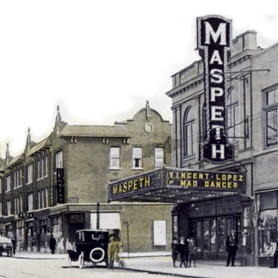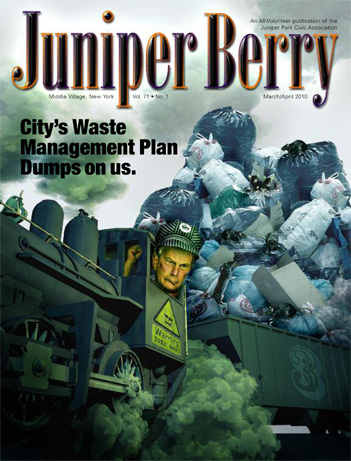This article is intended to provide a snapshot of Maspeth’s history, demographics and its people. Most residents either don’t know or have forgotten who we are and where we came from. This is a common trend in this country and it has led to a generation who has lost its national identity, is devoid of community loyalty and is oblivious to the lessons of history. So without too much grandstanding I would like to take this opportunity to fill you in on my take of who I am and where I came from. Be aware that I am not Methuselah so what I am about to write is the result of many conversations with those who came before me. As such I may not be 100% on target as some see it. In that case I would ask that others share their stories with the Juniper Park Civic Association so we can better document our history.
“The Country”
First, in order to provide a clearer understanding of the big picture, I must digress. Maspeth, like its immediate neighbors was once considered “The Country.” Manhattan was the initial center of civilization, being the manufacturing and business hub. Western Brooklyn served as the residential region for the general populous. People migrated largely from the eastern regions of Europe. Today, those early communities would be considered company towns as it was the wealthy business owners and early corporations who were responsible for the multiple family (cold-water flat) dwellings which were constructed to house the workers who were often given passage into this country in order to staff Manhattan based factories.
The different ethnicities, banded together by culture, family and friendship settled in different areas within the then relatively small city. They basically stuck to themselves, maintaining separate languages, cultures and neighborhoods, later settling into individually distinct areas throughout Brooklyn and Queens; i.e. Italians in East Williamsburg, Germans in Ridgewood, Irish in Sunnyside, Polish in Maspeth and so on. They tended to be clannish and territorial, with each maintaining their own unique community. They didn’t intermingle except when meeting in common places such as work, where, even there, they formed tightly knit groups according to various blue-collar trades. Social diversity didn’t exist and you basically stayed in your own neighborhood or a “butt kicking” could ensue.
This is just the way it was and the sad fact is that it required the horrors of two World Wars to end this situation. Maspeth paid a very high price for the win in WWII as many of its young men served and died in the European Theater and in the Philippines. Those who survived came to regard the different peoples with a bit more openness than their parents. As a result the fifties generation became diverse, with those of us who attended public school making no distinction between our classmates of Italian, German, Irish or Polish ancestry because they were simply our friends.
From Farming to Industrial
Early on, Maspeth served largely as a farm community and the last farm owned by Zahack became tracts of one and two family homes. Like most of America the Industrial Revolution brought about great change, progress and prosperity. Industrial areas were built in what is currently West Maspeth, in towns called Laurel Hill and Blissville (located east of Greenpoint Ave. & south of the LIE). Places like Nichols Copper (later became Phelps Dodge) Cicero Wire, VanIderstine, Stewart Lumber and General Chemical set up facilities along the Newtown Creek. People worked 12-hour days, Monday through Friday and 8 hours on Saturday.
No automation back then, work was via manual labor. As an example, in my grandfather’s era at Nichols, copper feed was loaded by hand and refined molten metal ladled out by hand. Work in a certain production department looked like something out of ancient Egypt. So we must give these early immigrants the credit they deserve, understanding that today’s work force probably wouldn’t last a day in such an environment.
As the expansion into Queens progressed, multiple family houses sprang up in Maspeth and in the surrounding communities. Middle Village and Glendale remained the country. Still a small town, Maspeth continued to maintain its unique character. Parks were empty fields and there were no televisions or computers. Social activity took place in dance halls such as National Hall and Clinton Hall. Fistfights were common (to some this was just the way to end a good night out) and no one was arrested. Local bars were another meeting place and some areas had a bar on nearly every block. Supermarkets hadn’t been invented so food was purchased fresh in small local shops. A trolley ran from the plateau area to what was once Niederstein’s and into Brooklyn. Later a Trolley Bus ran on what is presently the Flushing Avenue Bus Route and the “M’” Train used cars made of wood and ran open-air cars during summer months.
People went to Temple on Saturday or to Church on Sunday, there were no excuses, you went. You walked to school and women carried groceries in shopping carts. Sports consisted of playing baseball if you had the equipment, stickball when you had a broomstick to cut down or slapball when there wasn’t an old broomstick available. America and its armed forces were supported and Maspeth’s youth didn’t run from the call to duty. When the American flag was flown it was done so with honor because it was paid for with the blood of its people.
The LIE Splits Maspeth Down the Middle
In the early 1950’s the Long Island Expressway was built. Considered by many to be Maspeth’s ruination, it split Maspeth in two, with numerous residents losing their homes. Among these were both my grandparents, who were originally advised that the LIE would NOT go through their area. The politicians called it progress but it was Maspeth’s residents who paid the price, and many never recovered from their loss.
History is an outstanding teacher here; the politicians and agency officials couldn’t be trusted, even back some 60+ years ago when they were considered relatively honest! Think about this one! The LIE provided a quick means to drive to Long Island, even though most people didn’t have cars. It also brought accidents, air and noise pollution, congestion second to none and higher insurance premiums, as insurance companies consider living near the LIE a risk. Still, Maspeth survived and in the late 1970’s was described in the news as a bedroom community for Manhattan. The news should have kept quiet, as we were largely unknown. When you told someone you lived in Maspeth the answer was “where is that?” We should have remained a “where is that,” as this provided an ambiguity which protected our sovereignty, our way of life and our unique architectural character.
The Lost Maspeth
Today much of what comprised Maspeth’s flavor has been lost. Its classic buildings are being demolished in favor of oversized European style structures. Schools are popping up all over the place with many students coming from outside the community. P.S., People, local schools were intended to be for the community as in “LOCAL.” Our zoning regulations, freedom of choice, quality of life and rights are ignored and violated. History repeats itself; see above about the LIE.
So what is Maspeth’s future? The answer to this depends in part with its residents. Do we stick together and preserve our town or do we go with the flow and have whatever is left taken from us? In the late 1970’s city officials were planning on building a homeless shelter in West Maspeth. Our community stopped them, so it can be done. Truth is we don’t need what they are pushing. What Maspeth needs is what it had, an infrastructure of manufacturing, business and residents. This sustained the community for generations.
Just look at the local business areas where we went from places like Bohack, Janison’s Jeweler, Irmac’s, Woolworth’s, Times Square Store, Henry’s and Lodico’s Clothing, Maspeth and JP Auto and so on to a series of chain drug and fast food stores, banks, 99¢ stores and various other non-descript shops, which probably won’t last through this decade.
In retrospect we should have taken a lesson from our neighbors on Long Island and incorporated. At least this would have allowed us to maintain a reasonable level of control over the destiny of our community as opposed to being subjected to the rule of city politicians and other officials who have no loyalty to this community. Which would you rather have? You decide!




